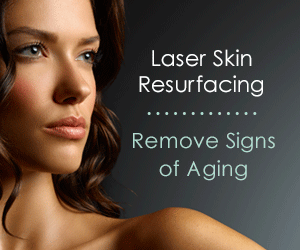
Laser Skin Resurfacing
Frequently Asked Questions
How does laser skin resurfacing work?
The laser delivers a series of tiny microscopic laser beams or columns into the skin. This fractionated energy penetrates the skin to clear away old and damaged skin cells. The body’s natural healing process then builds new healthy cells to take their place. The laser also stimulates the production of new collagen deep within your skin, giving you a more youthful looking appearance.
How long does the treatment take?
The treatment can be performed in as little as 30 minutes depending on the size of the area being treated.
How many treatments will I need?
Most people see their desired results in just one treatment however your doctor will determine the best course of treatment during your consultation.
What does the procedure feel like?
A topical anesthetic is generally applied before the procedure, so there is minimal feeling during the procedure. Some patients have reported feeling heat and tingling. How long will the results last? With proper skin care and protection, results often last years.
What should I expect immediately following treatment?
Immediately after the treatment, your skin will feel warm and appear to be sunburned. You may also experience some swelling, which is completely normal. Your body naturally starts working by replacing the aged skin cells with new ones. After a few days, you will notice healthier-looking skin and a more even complexion. Over time, collagen will regenerate and restore the supporting structure of your skin, giving you the smooth skin you are looking for.
When can I resume my daily activities?
Since skin resurfacing delivers fractionated pulses of energy you will experience a significantly shorter recovery time than with fully ablative lasers. Each tiny hole will quickly heal and you can return to your normal lifestyle in as little as four days.
What are the risks?
Fractional skin resurfacing has a faster recovery and has fewer side effects when compared to fully ablative resurfacing. Skin resurfacing treatments are generally well tolerated. During your consultation, we will explain any potential risks and help you minimize them based on your complete medical and skin history.
What to do after your skin resurfacing treatment?
- Immediately after treatment, it is common for your skin to feel warm and appear to be sunburned. Swelling and pinpoint bleeding may also accompany this.
- Ice/cold packs should be used as instructed for swelling and discomfort.
- To decrease healing time and minimize discomfort an occlusive ointment should be applied to the treated area.
- Avoid sun exposure during the first few weeks following the procedure. A broad-spectrum (UVA/UVB) sunblock SPF 50 or greater should be used for any transient exposure. If possible, cover treated area with clothing or use a wide brimmed hat to reduce exposure.
- Refer to your post-treatment care instructions provided by your doctor for more detail.
Request an appointment online or call (240) 686-1222. We will do our best to accommodate you.

 (240) 686-1122
(240) 686-1122 (240) 686-1124
(240) 686-1124


